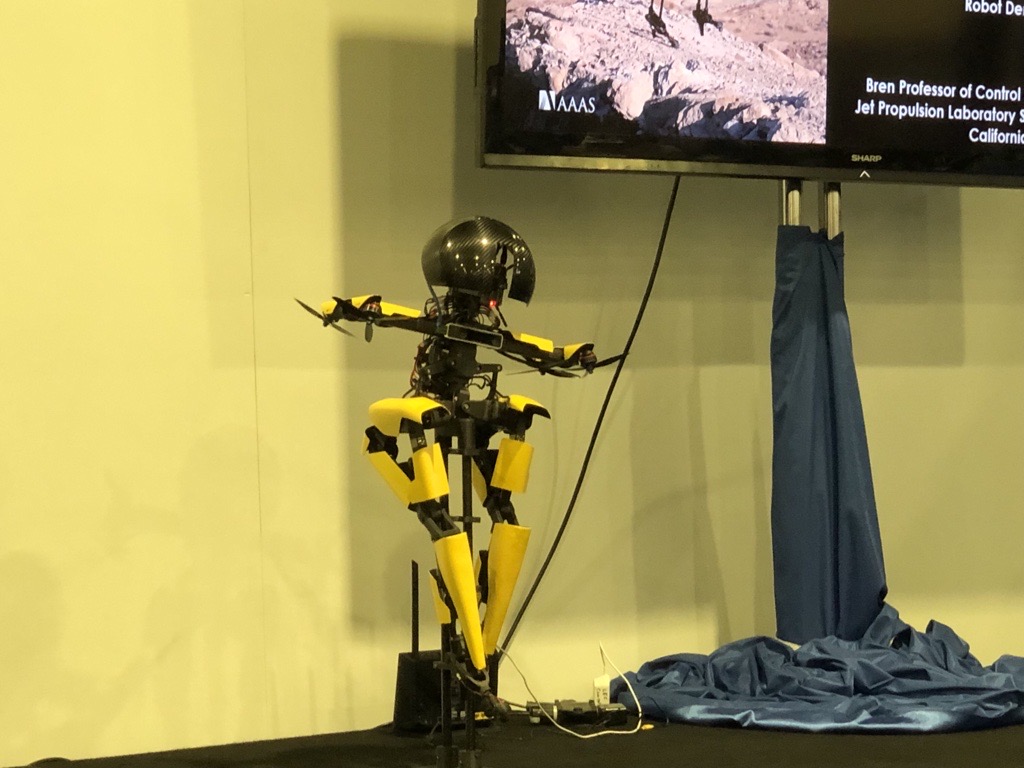Stay Up to Date
Submit your email address to receive the latest industry and Aerospace America news.
University’s first public demonstration of robot draws crowd of hundreds at AIAA’s SciTech forum
AIAA SCITECH FORUM, National Harbor, Md. — Caltech researchers showed off Leonardo, their flying, walking, skateboarding robot in its first public demonstration here on Thursday, drawing a crowd of hundreds to a stage in the exposition hall.
Caltech staff scientist Matt Anderson gently placed the thigh-high, yellow and black robot upright on its legs while activating a short walking program. Four propellers on its shoulders whirred into action, steadying the machine’s balance.
The robot began walking gingerly on its triple-jointed legs, while servo motors and propellers whined to a crescendo with each step to maintain balance. A few seconds later, near the far end of the stage, it stopped, tilting to the right briefly before the propellers rebalanced the tiny mechanical body.
The robot didn’t fly on Thursday, but Caltech has flown it outdoors many times at low altitudes to show how it can avoid obstacles, such as a steep stairway, merely by flying over them. Caltech calls Leonardo the world’s first bipedal walking and flying robot.
As fun as it is to watch the robot, it was built in part for the serious purpose of demonstrating a new landing technique, said Soon-Jo Chung, a professor of control and dynamical systems at the research institute and a senior research scientist at the nearby NASA-funded Jet Propulsion Laboratory, which Caltech runs for the agency.
He spoke before and after the robot’s walking demonstration, explaining that he believes Leonardo’s legs and propellers, and how they work together, can provide a novel landing method for the advanced air mobility industry, whose aircraft must land in places other than runways or even helipads.
“Conventional landing gear for airplanes or helicopters is kind of static, and there is no control provided by joints,” Chung said. “So you can actually imagine having this kind of control over your landing gear, and actually make sure that so-called ‘flying cars’ can land on sloping terrain, very challenging or uneven terrain.”
Chung said the key to Leonardo’s balance and landing ability is synchronized control of the servo motors and propellers to enable instantaneous adjustments in rotor speed and leg position that will provide balance.
In a 2021 paper in the journal Science Robotics, Chung and Caltech researchers describe how future Mars rotorcraft could be equipped with similar joint-legged landing gear so that balance can be maintained as they land on sloped or uneven terrains, thereby reducing the risk of failure during landing.
Get the latest news about advanced air mobility delivered to your inbox every two weeks.
About paul brinkmann
Paul covers advanced air mobility, space launches and more for our website and the quarterly magazine. Paul joined us in 2022 and is based near Kennedy Space Center in Florida. He previously covered aerospace for United Press International and the Orlando Sentinel.
Related Posts
Stay Up to Date
Submit your email address to receive the latest industry and Aerospace America news.




